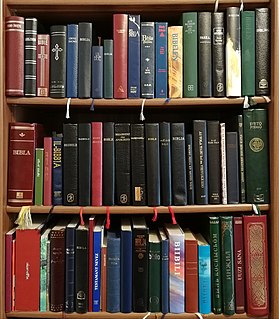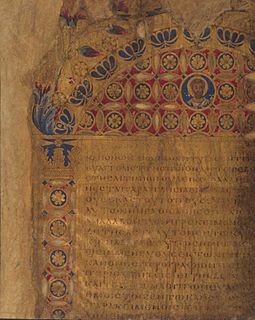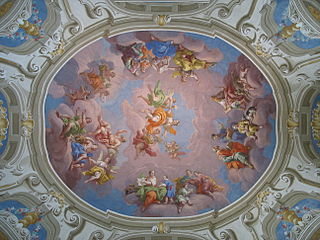Related Research Articles

The terms anno Domini (AD) and before Christ (BC) are used to label or number years in the Julian and Gregorian calendars. The term anno Domini is Medieval Latin and means 'in the year of the Lord', but is often presented using "our Lord" instead of "the Lord", taken from the full original phrase "anno Domini nostri Jesu Christi", which translates to 'in the year of our Lord Jesus Christ'. The form "BC" is specific to English and equivalent abbreviations are used in other languages: the Latin form is Ante Christum natum but is rarely seen.

Diophantus of Alexandria was an Alexandrian mathematician, who was the author of a series of books called Arithmetica, many of which are now lost. His texts deal with solving algebraic equations. Diophantine equations and Diophantine approximations are important areas of mathematical research. Diophantus coined the term παρισότης (parisotes) to refer to an approximate equality. This term was rendered as adaequalitas in Latin, and became the technique of adequality developed by Pierre de Fermat to find maxima for functions and tangent lines to curves. Diophantus was the first Greek mathematician who recognized fractions as numbers; thus he allowed positive rational numbers for the coefficients and solutions. In modern use, Diophantine equations are usually algebraic equations with integer coefficients, for which integer solutions are sought.

The New Testament (NT) is the second division of the Christian biblical canon. It discusses the teachings and person of Jesus, as well as events in first-century Christianity. The New Testament's background, the first division of the Christian Bible, is called the Old Testament, which is based primarily upon the Hebrew Bible; together they are regarded as sacred scripture by Christians.
Greek literature dates back from the ancient Greek literature, beginning in 800 BC, to the modern Greek literature of today.

Uncial is a majuscule script commonly used from the 4th to 8th centuries AD by Latin and Greek scribes. Uncial letters were used to write Greek and Latin, as well as Gothic and Coptic.

Classical Latin is the form of Literary Latin recognized as a literary standard by writers of the late Roman Republic and early Roman Empire. It was used from 75 BC to the 3rd century AD, when it developed into Late Latin. In some later periods, it was regarded as good or proper Latin, with following versions viewed as debased, degenerate, or corrupted. The word Latin is now understood by default to mean "Classical Latin"; for example, modern Latin textbooks almost exclusively teach Classical Latin.

The Bible has been translated into many languages from the biblical languages of Hebrew, Aramaic, and Greek. As of 2022 all of the Bible has been translated into 724 languages, the New Testament has been translated into an additional 1,617 languages, and smaller portions of the Bible have been translated into 1,248 other languages according to Wycliffe Global Alliance. Thus, at least some portions of the Bible have been translated into 3,589 languages.

Late Latin is the scholarly name for the form of Literary Latin of late antiquity. English dictionary definitions of Late Latin date this period from the 3rd to the 6th centuries CE, and continuing into the 7th century in the Iberian Peninsula. This somewhat ambiguously defined version of Latin was used between the eras of Classical Latin and Medieval Latin. Scholars do not agree exactly when Classical Latin should end or Medieval Latin should begin.
The toponym Albania may indicate several different geographical regions: a country in Southeast Europe; an ancient land in the Caucasus; as well as Scotland, Albania being a Latinization of a Gaelic name for Scotland, Alba; and even a city in the U.S. state of New York.

Anno Mundi, abbreviated as AM or A.M., or Year After Creation, is a calendar era based on the biblical accounts of the creation of the world and subsequent history. Two such calendar eras have seen notable use historically:

Byzantine literature is the Greek literature of the Middle Ages, whether written in the territory of the Byzantine Empire or outside its borders. It forms the second period in the history of Greek literature after Ancient Greek literature.

Latin is a member of the broad family of Italic languages. Its alphabet, the Latin alphabet, emerged from the Old Italic alphabets, which in turn were derived from the Etruscan, Greek and Phoenician scripts. Historical Latin came from the prehistoric language of the Latium region, specifically around the River Tiber, where Roman civilization first developed. How and when Latin came to be spoken by the Romans are questions that have long been debated.

The Byzantine calendar, also called Roman calendar, Creation Era of Constantinople or Era of the World, was the calendar used by the Eastern Orthodox Church from c. 691 to 1728 in the Ecumenical Patriarchate. It was also the official calendar of the Byzantine Empire from 988 to 1453 and of Kievan Rus' and Russia from c. 988 to 1700. This calendar was used also in other areas of the Byzantine commonwealth such as in Serbia, where it is found in old Serbian legal documents such as Dušan's Code, thus being referred to as the Serbian Calendar as well. Since Byzantine is a historiographical term, the original name uses the adjective "Roman" as it was what the Eastern Roman Empire continued calling itself.
Medieval Greek is the stage of the Greek language between the end of classical antiquity in the 5th–6th centuries and the end of the Middle Ages, conventionally dated to the Ottoman conquest of Constantinople in 1453.

The legacy of the Roman Empire has been varied and significant, comparable to that of other hegemonic polities of world history.

The Church Fathers, Early Church Fathers, Christian Fathers, or Fathers of the Church were ancient and influential Christian theologians and writers who established the intellectual and doctrinal foundations of Christianity. The historical period in which they worked became known as the Patristic Era and spans approximately from the late 1st to mid-8th centuries, flourishing in particular during the 4th and 5th centuries, when Christianity was in the process of establishing itself as the state church of the Roman Empire.
References
- ↑ See the definitions of "Late Greek" at Dictionary.com and TheFreeDictionary.com. Those two websites have the American Heritage Dictionary, the Random House Dictionary, and the Collins English Dictionary. Their definitions are approximately the same. At the dictionary at Merriam-Webster.com the definition of "Late Greek" is "the Greek language as used in the third to sixth centuries", which is a considerably narrower time-period than what is in the other dictionaries.